Slave states and free states
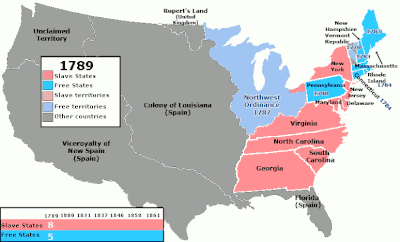
In thehistoryof theUnited States of America,aslave statewas aU.S. statein which the practice ofslaverywas legal at a particular point in time. Afree statewere the ones in which slavery wasprohibited.Slavery was anissuethat divided the country. It was one of theprimarycauses of theAmerican Civil War.TheThirteenth Amendment to the United States Constitution,ratified in 1865,abolishedslavery in every state andterritoryof the United States except in cases of punishment for criminal activity. After that time thetermsbecame more or lessobsoletebecause all states were free of slavery.
Early history
[change|change source]
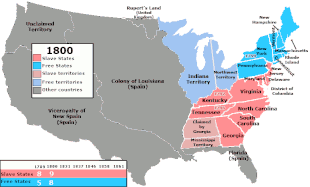
Slavery waslegaland practiced in each of theThirteen Colonies.[1]Organizedpoliticalandsocial movementsto end slavery began in the mid-18th century.[2]The desire forfreedomfrom Britain,expressedin theAmerican Revolutionary War,caused manyblackAmericans to join the revolution in hopes they would be freed also. Others joined theBritish Army,encouraged by British promises of freedom in exchange formilitaryservice. After the British lost the war, thousands were taken toNova Scotia.
In the 1770s, blacks throughoutNew Englandbegan sendingpetitionstonorthernlegislaturesdemanding freedom. At theConstitutional Conventionmany slavery issues weredebatedand for a time slavery was a majorobstacleto passage of the new constitution. As acompromisetheinstitutionof slavery wasacknowledgedalthough never mentioned directly in the constitution. Anexampleis theFugitive Slave Clause.By 1789, five of the Northern states had policies that started to gradually abolish slavery:Pennsylvania(1780),New HampshireandMassachusetts(1783),ConnecticutandRhode Island(1784).Vermontabolished slavery in 1777, while it was still independent. When it joined the United States as the 14th state in 1791, it was the first state to join that had no slavery. By 1804 all of the northern states had abolished slavery or hadplansin place to gradually reduce it.[3]There were 11 free states and 11 slave states. Later came the civil war.
In theSouth,Kentuckywas created as a slave state from a part ofVirginia(1792).Tennesseewas created a slave state out of a part ofNorth Carolina(1796). By 1803, afterOhiohad been admitted to the United States, there were nine free states and eight slave states.[4]Thegeographicdivide between northern free states and southern slave states became theMason–Dixon line.In 1820, theMissouri Compromiseextended the Mason–Dixon linewestwardas the official dividing line between free and slave stateseastof theOhio River.[5]
New territories
[change|change source]
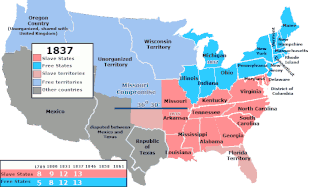
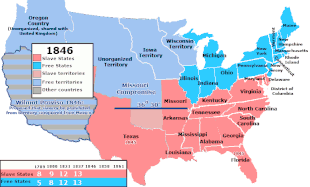
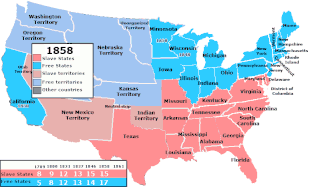
TheNorthwest Ordinanceof 1787, passed just before theU.S. Constitutionwasratified,prohibited slavery in theNorthwest Territory.The southern boundary of the territory was theOhio River.This was regarded as a westward extension of the Mason–Dixon line. The territory was generallysettledbyNew Englandersand American Revolutionary Warveteranswho weregrantedland there. The states created from the territory –Ohio(1803),Indiana(1816),Illinois(1818),Michigan(1837),Iowa(1846),Wisconsin(1848), andMinnesota(1858) – were all free states.
War of 1812
[change|change source]During theWar of 1812,the British accepted all slaves who came into their hands as free. This was without anyconditionsas to military service such as had been made in theRevolutionary War.By the end of the War of 1812, the momentum for antislaveryreform,state by state, appeared to losemomentum.Half the states had already abolished Slavery, had prohibited it from the start or were in the process of eliminating slavery. The other half were committed to preserving slavery within their borders.
At thefederallevel politicians were concerned over the balance of power in the United States.[6]Each state had twosenatorsso if there were an equal number of states on both sides of the issue, nothing could be done on the federal level. With an equal number of slave states and free states, the Senate was equally divided on issues important to the South. Both the North and South were concerned over the western territories and whether new states would be admitted as free states or slave states.[6]
Missouri Compromise
[change|change source]Controversy over whetherMissourishould be admitted as a slave state, resulted in theMissouri Compromiseof 1820. This specified thatLouisiana Purchaseterritory north of latitude 36° 30', which described most of Missouri's southern boundary, would be organized as free states. Territory south of that line would be reserved for organization as slave states. As part of the compromise, the admission ofMaine(1820) as a free state was secured to balance Missouri's admission as a slave state (1820). The growing population in the industrialized North resulted in the House of Representatives having more free state votes than slavery votes. To overcome this imbalance, in 1836 the House instituted a "gag rule" forbidding the House from considering any anti-slavery petitions.[7]It wasrepealedon December 3, 1844.[7]
Texas and the Mexican Cession
[change|change source]The admission ofTexas(1845) and the U.S. obtaining the vast newMexican Cessionterritories (1848) after theMexican–American Warcreated further North-South conflict. Although the settled portion of Texas was an area rich in cotton plantations and dependent on slavery, the territory acquired in the Mountain West did not seem hospitable to cotton or slavery. As part of theCompromise of 1850,Californiawas admitted as a free state (1850), without a slave state pair. To avoid creating a free state majority in the Senate, California agreed to send one pro-slavery and one anti-slavery senator to Congress.
Last battles
[change|change source]The difficulty of identifying territory that could be organized into additional slave states stalled the process of opening the western territories to settlement. Slave state politicians sought a solution, with efforts being made to acquireCuba(seeOstend Manifesto,1852) and to annexNicaragua(seeWalker affair,1856–57). Both were to be slave states.
In 1854, the Missouri Compromise of 1820 was superseded by theKansas–Nebraska Act.This allowed white male settlers in the new territories to determine throughpopular sovereigntywhether they would allow slavery within each territory. The result was that pro- and anti-slavery elements flooded into Kansas with the goal of voting slavery up or down. This led to the conflict known asBleeding Kansas.[8]An effort was attempted to organizeKansasfor admission as a slave state. It was to be paired with Minnesota as a free state. But the admission of Kansas as a slave state was blocked because of questions over the legitimacy of its slave state constitution. Anti-slavery settlers in Kansas in the 1850s were calledFree-Soilers,because they fought (successfully) to include Kansas in the Union as a free state in 1861. When the admission of Minnesota proceeded unimpeded in 1858, the balance in the Senate was lost.Oregonwas admitted in 1859 as a free state.
End of slavery
[change|change source]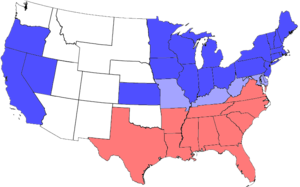
At the start of the Civil War, there were 34 states in the United States, 15 of which were slave states. Of these, 11 slave states declared their secession from the United States to form theConfederacy.The slave states that stayed in the Union were Maryland, Missouri, Delaware, and Kentucky, and were referred to as theborder states.By the time theEmancipation Proclamationwas made in 1863 Tennessee was already in Union control. So the Proclamation applied only to the 10 remaining Confederate states. Abolition of slavery also became a condition of the return of local rule in those states that had declared their secession. The Thirteenth Amendment to the United States Constitution abolished slavery throughout the United States on December 18, 1865, ending the distinction between slave and free states.
References
[change|change source]- ↑Betty Wood,Slavery in Colonial America, 1619–1776(Lanham, MD: Rowman & Littlefield Publishers, 2005), p. x
- ↑Nell Irvin Painter,Creating Black Americans: African-American History and Its Meanings, 1619 to the Present(Oxford; New York: Oxford University Press, 2006), pp. 70–72
- ↑Theodore Brautner Wilson,The Black Codes of the South(Tuscaloosa: University of Alabama Press, 1965), p. 15
- ↑Slavery in the United States: A Social, Political, and Historical Encyclopedia,vol. I, ed. Junius P. Rodriguez (Santa Barbara, CA: ABC-CLIO, 2007), p. 30
- ↑John Mackenzie."A brief history of the Mason-Dixon Line".University of Delaware. Archived fromthe originalon 17 July 2018.Retrieved26 June2016.
- ↑6.06.1"Theme:The Slavery Debate".U.S. Capitol Visitor Center. Archived fromthe originalon 8 September 2016.Retrieved26 June2016.
- ↑7.07.1"The House" Gag Rule "".Office of Art & Archives, United States House of Representatives. Archived fromthe originalon 8 September 2016.Retrieved26 June2016.
- ↑Nicole Etcheson,Bleeding Kansas: Contested Liberty in the Civil War Era(2006) ch 1
